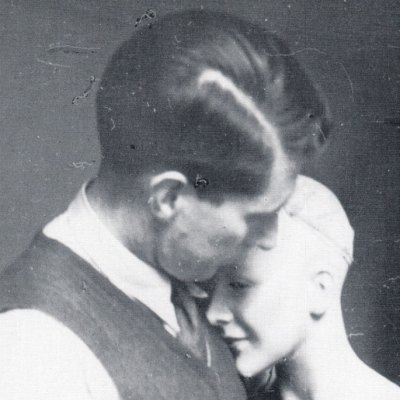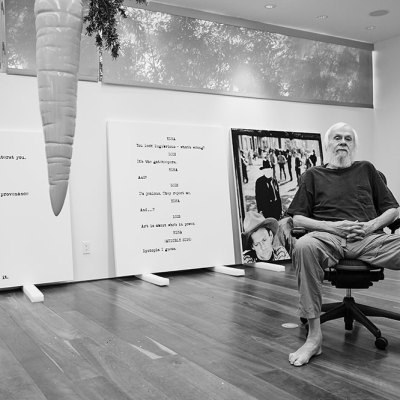He started in the art world on the West Coast, as a dealer of Surrealist art in Beverly Hills. Next, he made his way to Paris where Brancusi was his next-door neighbour (it took two months for the Romanian sculptor to finally smile at him in the street). Finally, the artist William N. Copley (1919–96) ended up back where he was born, in the city of New York, where, in the 1960s and ’70s, he became one of the most underrated Surrealist painters of his generation.
It was in New York that Copley, who exhibited with Alexander Iolas throughout this period, perfected his bold, forthright style, assisted by his switch from oil to acrylic paint. New York was also where he found himself in the middle of a now-legendary social scene (Andy Warhol wrote in his diaries: ‘I need to write a play about [Copley’s] life.’). It was where he started his own small press (the Letter Edged in Black Press, founded in 1968), and where he turned his apartment on 81st Street into a hub for an open-ended group of collaborators from Yoko Ono to Marcel Duchamp (for whom he wrote an obituary in the New York Times).
Revolver and Target (1970), William N. Copley. Courtesy Kasmin Gallery; © 2020 William N. Copley Estate/Artists Rights Society (ARS), New York

Copley’s location is important when discussing his work, since it defines the artistic movements that in turn informed his ideas. He spent the 1950s in France, as the Surrealists deepened interest in depicting the psychological algebra of dreams, and when he returned to New York, he was surrounded by the cheeky critiques of communal values in Pop art. Peter Schjeldahl wrote of Copley that he was one of a group of ‘hothouse gardeners, producing from delicate European seedlings, in the ambience of their own idiosyncrasies, exotic native blooms’.
Schjeldahl’s evocative text from 1971 is reproduced in a newspaper for a show on Copley at Kasmin Gallery, which focuses in on the New York period of painter’s life. The show (currently closed to the public due to Covid-19, but available for virtual tours by appointment) introduces the viewer to the artist’s visual tics: the bowler hats, herringbone print and faceless figures that have more than a little of the cartoon Popeye about them.
McQueen (1974), William N. Copley. Courtesy Kasmin Gallery; © 2020 William N. Copley Estate/Artists Rights Society (ARS), New York

While it’s easy to understand Copley (whose artist signature was styled CPLY) as treating Surrealist themes with a Pop art aesthetic, the artist developed an eccentric sensibility all his own. Nowhere is this more evident than in his treatment of sex. In the X-rated series (1972–75), for example, which took erotic scenes cribbed from dirty magazines purchased in Times Square, Copley blows up his subject material in bright colours – but also, somehow, makes it fun. The joy and the lack of judgement in these scenes of entwined bodies make them sexual while avoiding lechery. Even though the eye-popping outlining and foreshortened space can feel almost cartoonish, these depictions are as awkwardly charming as the real thing can be.
Also included in the Kasmin show is his Nouns series, begun in 1970. Each work represents a single object, often taken from a Sears catalogue. In one painting, a trombone looms too close, golden yellow on a red-orange Op-art cube; in another, a revolver is opened to show an empty barrel against a green and purple target. At Kasmin, Revolver and Target (1970) is placed next to the painting McQueen (1974), a snaking hand of fingers sneaking into a bare behind, bringing out the Surrealist sexual undertones of these works.
I am Awarded My Handbag and Declared a Professional (1986), William Copley. Courtesy Kasmin Gallery; © 2020 William N. Copley Estate/Artists Rights Society (ARS), New York

A jaunty painting from 1965 titled Tomb of the Unknown Whore (No. 2) shows a pedimented building, adorned with lace-clad women, one of the tropes that recur frequently. The almost three-metre-wide painting’s title was also the name of his retrospective at the New Museum in 1986. For this interactive show, Copley encouraged visitors to draw on the walls and paintings with chalk – indeed, at the Kasmin show, it’s still possible to make out the names ‘Shonda’ and ‘Michelle’ in white residue on the work I am Awarded My Handbag and Declared a Professional (1986). Copley’s extraordinary biography provides context for his reverent treatment of sex workers: it was around this time that he was briefly married to Marjorie Annapav, who had previously worked in a brothel, and who married him in exchange for $600,000.
It’s hard not to view William N. Copley’s work through the lens of his life and connections. But by focusing on this period in the painter’s life as a discrete chunk, ‘William Copley: the New York Years’ shows the particular way he brought Surrealism and Pop art together and made them his own.
Kasmin Gallery is temporarily closed to the public due to the Covid-19 outbreak. For more information on ‘William N. Copley: The New York Years’ visit the gallery’s website, which also hosts a tribute to its late founder, Paul Kasmin (1960–2020).



